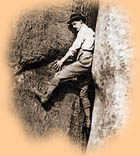|
Historical Rock Climbing
Images
|
Page
2
Elbsandsteingebirge & Similar Areas . . . |
 Several badges of the more than 200 small climbing clubs in Saxony by the 1930s |
Technique, Difficulty, Ethics . . .
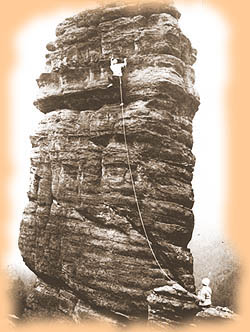 Perry-Smith leading Schiefer Turm, Alterweg (VI = 5.6/5.7) 1905 Photo Walter Hahn |
During
the first few years of the twentieth century technique advanced rapidly
in the Elbsandsteingebirge, as did ethical and even aesthetic
considerations. The concept of "Great Lines" was proposed by Rudolf Fehrmann : the most beautiful line was one that ascended directly, over considerable difficulties. Some of the routes thus designed were very risky, as well as fatiguing and technically demanding.
During this period climbers began to move out onto the steep faces, away from the relative comfort of cracks and chimneys, and contend with marginal, down-sloping holds and great exposure - leading Fehrmann to define: "The ultimate objective of friction climbing as the art of overcoming steeply inclined steps and holds which are not sharply edged (i.e., rounded downwards) and this also at great height, with poor or limited possibility of belaying." |
| Rudolf
Fehrmann was
probably the equal of his American partner.
"Fehrmann was a wonderful climber and much of
Perry-Smith's success was due to his inspiration and guidance. Fehrmann
realized early that, in order to preserve climbing
in Saxon Switzerland unspoiled, the use of artificial aid had
to be prevented. He was the brain and leader of the early climbers
and was able to convince them by lectures and writing that once
strict rules were broken there would be no end to it, and the beautiful
towers and pinnacles would lose much of their natural charm and
challenge" Dr. Rudolf Fehrmann was an attorney. Unfortunately, he fell under the spell of the National Socialist Party and became an early member of that organization. He did manage, in the 1930s, to use his Party influence to remove unnecessary restrictions to climbing in the Elbsandstein area. He served as a military judge during World War II, and was captured and sent to an internment camp in East Germany (Camp Five-Oaks near Brandenburg), where he died of "natural causes" - awaiting trial as a suspected war criminal - in March of 1948, at the age of 63. |
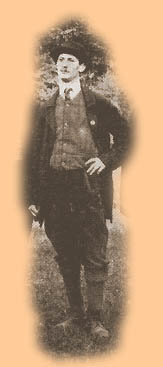 Rudolf Fehrmann |
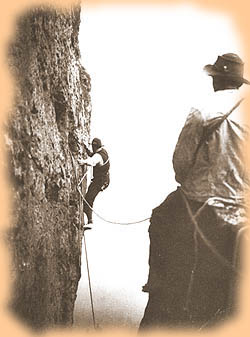 Perry-Smith traversing into FA of Südriss (VIIa = 5.7/5.8) on Falkenstein 1913 belayed by K. Hradezky Photo Walter Hahn |
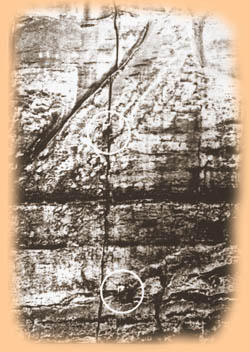 Falkenstein E. Renger on Südriss 1920 Photo
Walter Hahn
|
| Thorington speaks of climbing practices in Elbsandsteingebirge prevailing from the early 1900s through the first half of the century: "Considering the great difficulty and exposure, very few safety rings are used. Only a leader of a new climb has the right to place a ring, and it stays as a permanent fixture . . . it is considered bad form to employ many rings . . . Regular alpine pitons are not suitable for the soft sandstone . . . holes are drilled, usually 5 or 6 inches deep, with a crown chisel about 14 mm in diameter, and then the shaft of the ring is driven in together with wood or lead pieces to make it fit solidly. . . The rings are meant only for belays . . ." |
Artificial Aid - or Not ?
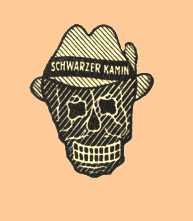 Schwarzer Kamin emblem |
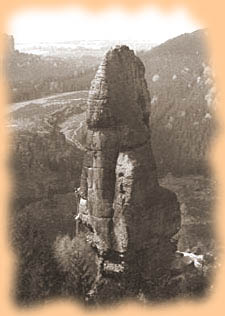 Haupt-Drilling
A later, more difficult ascent
|
| Although
the levels of difficulty were considered quite high, and ethical
standards quite rigorous, a somewhat
different attitude existed concerning artificial
aid. Pounding something into the rock and
putting weight on it was not condoned, but a philosophical attitude
of "two
bodies, one climber" was acceptable. Perry-Smith himself describes the ethical envelope - on the first ascent of what Perry-Smith calls the Drilling Needle [Haupt-Drilling] on October 11, 1908 - and, in addition, gives us an understanding of the level and severity of competition existing in the region: "Hoyer stood beside the smooth groove, Hünig on his shoulder, while from the side I shoved Hünig higher and finally held him on my hand until he secured a hold and could overcome the difficult spot. . . . After a traverse to the right and 5 meters upward, Hünig advanced and climbed on my arm. . . . below the top he met difficulty . . . he shot down, fell on my back, then through the air. His rear end struck the rock with a bang and blood streamed from his head like a cloudburst, reddening the stone. He soon sat up on the ledge and cursed God and the world in general . . . it seemed my duty to advance, particularly since there were observors below, some carrying the black flag with death's head of the Schwarzer Kamin [the Dresden club of which the party were members]. After many
attempts and placing a ring I ascended, traversed
to the right and at 2:30 reached the summit and planted our
flag. The others came up on the rope, and the ascent would have been
impossible without such comrades. The Drilling is 31 meters high, much
higher than I thought, and now I have shut Löschner's mouth."
- Letter
to R. Fehrmann, dated October 12,
1908. [Paul Löschner
was one of the top climbers of the time. He had told Perry-Smith that
he had tried the Drilling already and knew it was
impossible. He fell to his death three months later]
In another incident, Perry-Smith writes in a letter of his climb of the summit block of the Jungfrau in the Alps: ". . . We stood together in small footsteps with smooth rock in front and nothing at all for the fingers to hold. The summit was gained by shoving Hünig over the smooth rocks until he could grasp the top with his fingers." In fact, after a two hour effort to drive in safety-rings, "Hünig climbed on Perry-Smith's knee, then on his shoulder, but still could not reach the top scarcely a meter away. Only when Perry-Smith raised him with out-stretched arm could he grasp the peak . . ." (Thorington). |
Empornadel
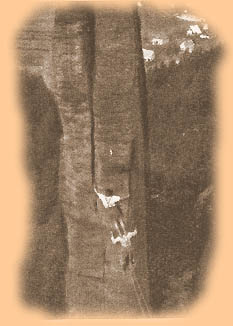 Fritz Scheffler - On the first 'free' climb of the spire |
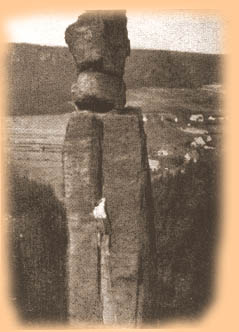 Shoulder-stands
on Empornadel,
ca. 1930
(Ostrov area of the Czech Republic) |
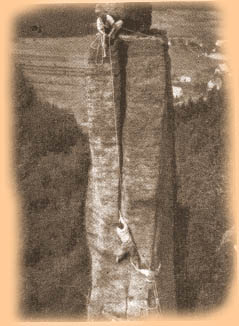 Photos Anni Scheffler |
Barbarine
A
Spectacular Pinnacle Climbed by the Perry-Smith/Fehrmann Team . . .
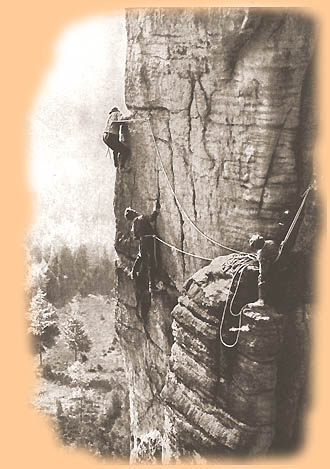 |
Barbarine
(VI = 5.6/5.7) FA by R. Fehrmann & O. Perry-Smith, 1905 Photos
Walter Hahn
Valley Side Route (VIIc = 5.9/5.10) FA by Pokorny, Richter, Hermann, and Hofmann 1924 |
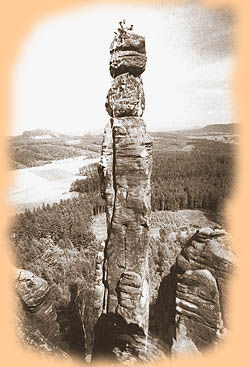 |
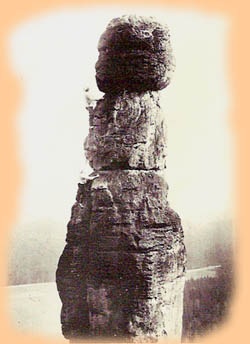 Near the Summit Photo Walter Hahn |
This beautiful spire is now classified as a natural monument and is closed to climbing
| Click here to view a humorous postcard produced in 1904, depicting what the artist guessed climbing on Barbarine would be like in 1910 |
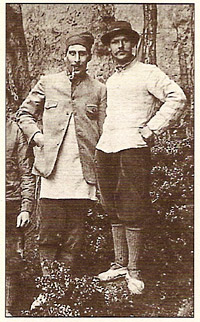 Perry Smith and Walter Hünig |
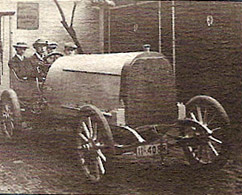 Perry Smith and his Bugatti Rennauto |
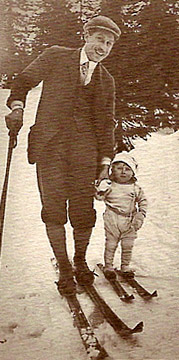 Perry Smith and son, Ollie |
Back in the USA . . .
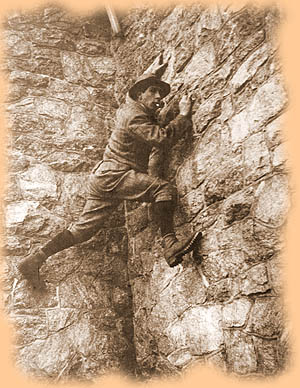 |
Perry-Smith
& Buildering . . . Perry-Smith returned to Philadelphia for a year or so, before leaving again for Dresden in August of 1905. In America, he practiced climbing on the stone walls of a house and also ascended the exterior of office buildings - before being shooed off by police for causing traffic jams. A friend called him a "human fly". Perry-Smith on the walls of his summer home at Wyncote, PA, 1903. Photo courtesy Henry S. Hall, Jr. American Alpine Club Library |
